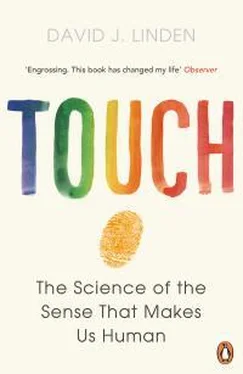In human behavioral science, disentangling nature-versus-nurture problems often involves studies in which twins are adopted into different families. It’s possible to do something similar with rats. Two pups from the litter of a low licking-grooming mother were removed from her within twelve hours of birth, marked with a Sharpie for identification, and then cross-fostered by adding them to the litter of a high licking-grooming mother. When the pups grew up, they had reduced behavioral and hormonal stress responses as compared to their nonadopted siblings. The cross-fostered female pups were also much more likely to grow up to become high licking-grooming mothers themselves. Conversely, pups adopted in the other direction, from high to low licking-grooming mothers, had increased stress responses, and the female pups tended to grow up to become low licking-grooming mothers. 17These results, together with the beneficial effects of human handling on the pups of low licking-grooming mothers, argue for behavioral rather than genetic transmission of stress reactivity. But the effects of high licking-grooming behavior must somehow be changing the brains and hormonal systems of the pups, so the effects are still fundamentally biological. In fact, we now know some of the biochemical details of how maternal licking-grooming persistently modifies gene expression to underlie behavioral transmission across generations. These “epigenetic signals” are some of the molecular events where nature and nurture meet. 18
If raising pups that are resilient to stress is good, then why don’t all the rat mothers engage in lots of licking and grooming, thereby giving their pups an advantage as they make their way in the world? This type of selection can occur even if the mode of transmission is behavioral, not genetic: If the pups of low licking-grooming mothers are at a disadvantage in survival and reproduction, then wouldn’t high licking-grooming behavior come to dominate? The answer is complex and not entirely clear. Since wild Norway rats inhabit a great variety of ecological niches, from city dumps to meadows to forests, they must contend with a broad range of ecological demands, including different predators, food sources, and weather. Michael Meaney and his coworkers have suggested that in some ecological niches, like those with scarce food or abundant predators, it might be advantageous to have a high degree of stress reactivity, as imparted by a less-attentive mother rat: When confronted with the constant danger of being eaten or starving, it can be adaptive to be high-strung. One simple idea about how this might come about is the all-too-familiar work/home-life balance: In an echo of human societies, mother rats that have to range far and wide for food leave the nest more often and thereby have less time to lick and groom their pups.

What does the connection between maternal tactile stimulation and stress responses in rats tell us about other species? Let’s have a look, first down, and then up, the phylogenetic tree. The tiny soil-dwelling, bacteria-eating roundworm called C. elegans is about 1 millimeter long when it reaches adulthood, about three days after hatching. This creature is a favorite of biologists because it is easy to grow in the lab, it has a fast generation time, and it’s transparent. We now have a complete map of its adult nervous system, which consists of 302 neurons (compared with about 500 billion in the human brain). Only six of them are touch receptors embedded in the body wall. These touch-sensor neurons provide information that triggers the worm to swim forward or backward, depending upon what it encounters (soil particles, liquid surface tension, another worm). When newly hatched worms were allowed to develop together in groups of thirty to forty in a laboratory dish filled with nutrients, they attained their full length, similar to wild worms collected from soil samples. When these adult, colony-raised worms had their touch receptors stimulated by a tap on the edge of the dish wall, they typically reversed direction and began swimming backward. However, when a worm egg is isolated in a dish, hatches, and grows up in isolation from other worms, it will not attain its potential mature length and will respond more weakly to taps to the dish wall. The isolated worms tend to just keep swimming straight ahead, as if they do not feel the vibration.
Catharine Rankin and her colleagues at the University of British Columbia found that they could completely reverse the developmental deficits in both body length and touch sensation with a surprisingly crude maneuver: placing a dish containing a worm within twenty-four hours of its hatching in a padded box and repeatedly dropping the box from a height of two inches onto a table thirty times over the course of a few minutes. 19This treatment also reversed some biochemical and structural changes in the six sensor neurons thought to impair their ability to communicate touch events to other neurons. Even in an organism as simple as the worm, with no mother involved in child rearing and only six touch-sensitive neurons, tactile stimulation is important for development of the body and the nervous system, with effects persisting into adulthood.
In humans, touch is thought to be the first sense to become functional in utero, at about eight weeks’ gestation. At that point, the human fetus is about 1.5 centimeters long, weighs about a gram, and is exhibiting its first brain activity. Touch reception continues to develop from reflexive to intentional behavior as pregnancy progresses. I have fond memories of watching my unborn twins on the ultrasound monitor responding to each other’s kicks and blows during the last trimester of pregnancy. Jacob would stomp on Natalie’s head, and she would respond with a staccato jab to his belly. It looked for all the world like fetal martial arts.
Once human children are born, most mothers and fathers give them sufficient tactile attention. Children do not suffer lasting health problems because they didn’t receive daily baby massages, listen to Baby Einstein CDs, or get entertained by motorized crib mobiles. Studies that have investigated the role of touch sense in child development have, however, examined cases of drastic touch deprivation, as occurred in understaffed orphanages or with premature babies isolated in incubators. There have now been many such studies, and the results are clear: Severely touch-deprived infants and preemies have a broad range of developmental problems, ranging from impaired growth, increased vomiting, and compromised immune system function to slowed cognitive and motor development and the emergence of attachment disorders. As in rat pups, these effects were not limited to early life. Persistent touch deprivation of infants results in a significantly higher incidence of obesity, type 2 diabetes, heart disease, and gastrointestinal disease in adulthood. Adult neuropsychiatric problems are also found at a much higher rate, including anxiety, mood disorders, psychosis, and poor impulse control. 20
Of course, one must be appropriately critical of these epidemiological studies: For example, babies raised in understaffed orphanages are likely to be malnourished and have substandard medical care as well, and are more likely to grow up poor. Likewise, premature infants have a host of developmental problems that are unrelated to touch deprivation. What’s important to realize is that although studies of correlation can never be definitive as to cause, careful methods of analysis can increase confidence in their causal nature. For example, appropriate design and statistics have shown that there are strong effects of touch deprivation even when populations are normalized for nutrition, medical care, or poverty. 21
Читать дальше













